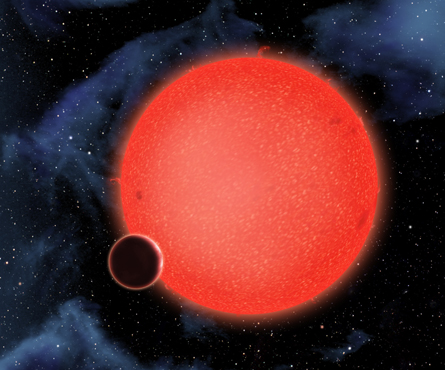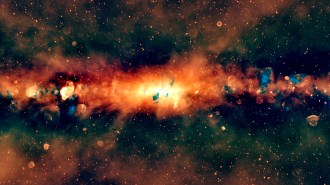A new class of planet has emerged from the buzzing masses of celestial spinners, a type unlike the rocky, gassy and icy worlds shuffling around the solar system.

The poster-planet for this new order is GJ 1214b, first discovered in 2009 and now shown to be a steamy, water-rich sphere. But it’s not a water-world in the sense of splashing oceans and Kevin Costner: Scientists suspect that the planet’s interior is filled with some exotic, high-pressure form of solid H2O unlike anything seen on Earth.
The planet is just 6.5 times more massive than Earth and about 2.7 times bigger in diameter. It circles a small star about 42 light-years away.
“It’s an exciting thing that we don’t have in our solar system,” says Lisa Kaltenegger, an astronomer who divides her time between Germany’s Max Planck Institute for Astronomy in Heidelberg and the Harvard-Smithsonian Center for Astrophysics in Cambridge. “And it’s a fun puzzle trying to figure out what the atmosphere of that planet is really made of.”
Astronomers sniffed out the latest details using the Wide Field Camera 3 aboard the Hubble Space Telescope. It’s not the first time GJ 1214b has been peered at, but the new study both confirms and sharpens previous observations.
As the planet passed in front of its star, the team could study its atmosphere at a range of infrared wavelengths, and from there could estimate the planet’s composition — a mystery because of its low density. The atmosphere is at least half water and is probably clustered near the planet’s surface, says Zachory Berta, a graduate student at the Harvard-Smithsonian Center for Astrophysics and coauthor of the study describing the planet’s properties, which will appear in the March 1 issue of The Astrophysical Journal.
The interior, Berta says, is probably largely water molecules instead of primarily something like rock. But it’s not water in familiar frozen or liquid forms.
“We’re not talking about either a frozen core of normal ice or a liquid water ocean,” Berta says. “You’re getting into weird states of matter when you’re describing this.”







